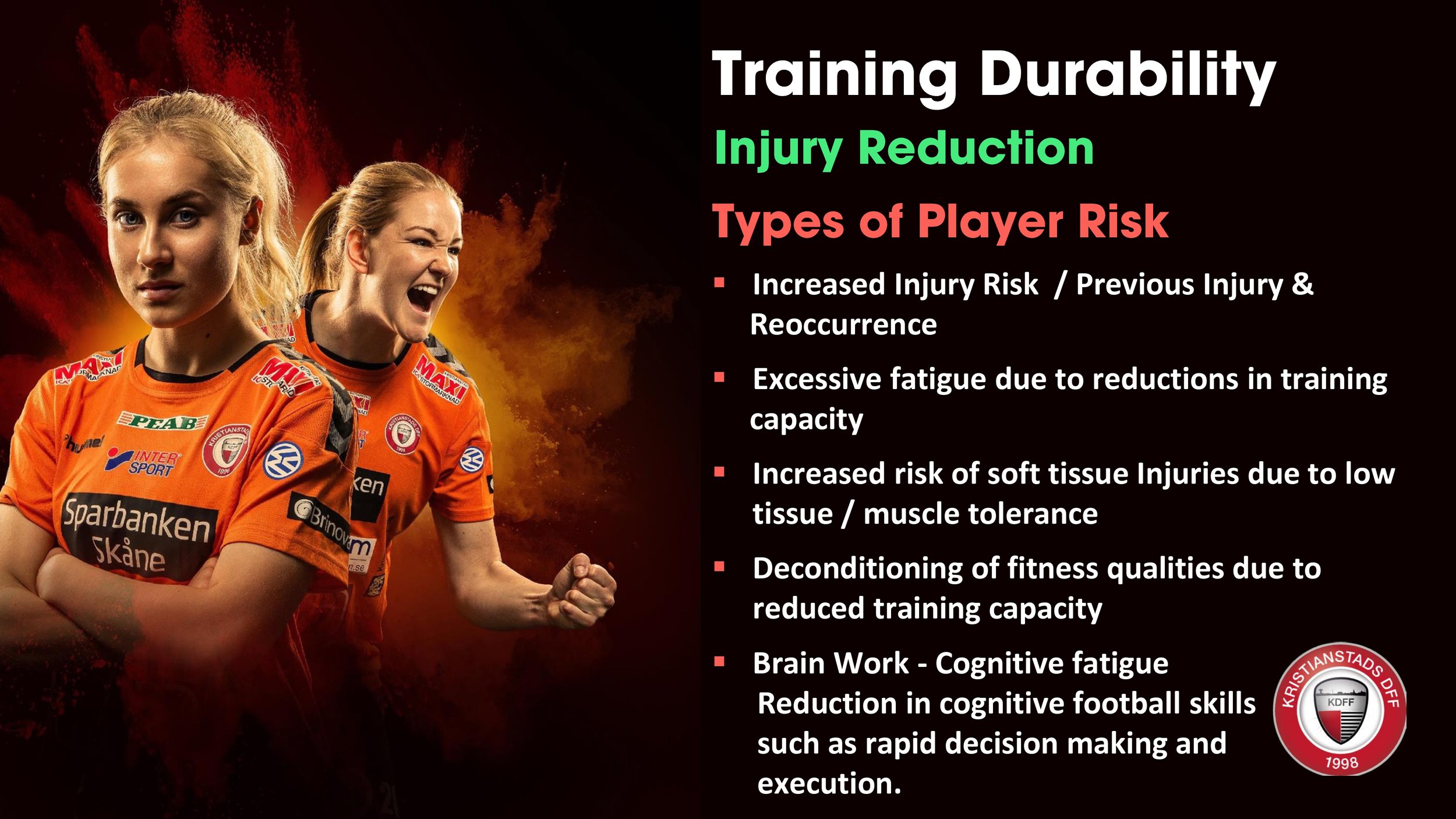Training Durability Player Guide
Training Durability
Better Player Health
Click on Green Button for the free pdf download
⚽ I created this guide for a team I used to work with in the top Women’s Swedish league in the Damallsvenskan called Kristianstads DFF. I put this document together for the players and coaches, as newish to this preparation.
Becoming A Better Team
🏆 As well as playing in the Damallsvenskan, KDFF played UEFA Women’s Champions league football.
Training Durability provides a comprehensive framework aimed at improving player health, robustness, and performance sustainability for professional soccer-football players, particularly in the context of demanding competitions like the Champions League.
1. Core Concepts and Objectives
Training Durability Defined:
The program focuses on enhancing players' ability to withstand the physical and cognitive demands of professional soccer, reducing injury risk, and maintaining high performance across congested fixture schedules.Key Goals:
Injury reduction and robustness
Improved aerobic fitness and technical skill integration
Better recovery and adaptation capacity
Sustained performance during critical periods (e.g., last 75 minutes of matches, congested schedules)
2. Program Components
Athletic Development Programme:
Focuses on general athleticism, strength, speed, and power tailored to individual needs, emphasising injury reduction and physical robustness.Intimidation Programme (Upper Body):
Designed to build physical presence and power to dominate opponents, setting a psychological and physical tone from the start.Training Durability Programme:
A phased approach to gradually build training capacity, focusing on reducing injuries and niggles by improving all fitness qualities, including aerobic base, muscle tolerance and readiness.
3. Injury Risk and Recovery Insights
Types of Player Risk:
Previous injury and reoccurrence
Excessive fatigue from reduced training capacity
Low tissue/muscle tolerance leading to soft tissue injuries
Cognitive fatigue impacting decision-making and execution
Critical Periods:
Injury rates increase significantly when players have less than 4 days of recovery between matches. Fatigue leads to reduced muscular force and contraction speed, increasing muscle strain and joint injury risks, especially late in the season during high-stakes matches.Recovery Focus:
Emphasises the importance of recovery strategies that address both physical and psychological fatigue, including nutrition, hydration, sleep, and psychological health and wellbeing.
4. Training Load Management
Weekly and Match Day Loads:
The program stresses coping with high training and match loads, especially during congested schedules typical in Champions League campaigns. Athletes who are stronger and fitter can better "bounce back" from intense sessions.Adaptation and Consistency:
Consistent training availability and quality recovery enable players to maintain performance levels and reduce injury risk over the season.
5. Physical and Psychological Attributes - Values
The program highlights the importance of developing a range of physical qualities:
Speed, strength, agility, and robustness
Cognitive resilience for rapid decision-making under fatigue
Psychological factors such as confidence, determination, and professionalism
Values: Athlete Self-Assessment:
Encourages players to take ownership of their fitness, nutrition, recovery, and mental state, fostering accountability and self-sufficiency.
6. Foundational Movement and Strength
The program builds foundational capacity focusing on:
Lower limb strength (gastrocnemius, soleus, knee flexion/extension)
Hip strength and pelvic control
Dynamic trunk control to reduce fatigue and injury risk
These foundational elements support the "Return to Performance" phase and help players maintain capacity to endure training and match demands without breakdown.
7. Practical Takeaways for Champions League Preparation
Progressive, Individualised Training:
Gradually increase training intensity and volume to build durability while respecting individual player needs and injury histories.Load Monitoring and Recovery:
Track weekly loads carefully, especially during congested fixtures, ensuring adequate recovery to prevent injury spikes.Holistic Approach:
Combine physical training with nutrition, hydration, psychological support, and sleep hygiene to optimise readiness.Psychological and Physical Resilience:
Develop not only physical robustness but also the mental resilience required for high-stakes, high-pressure matches.Team-Wide Athleticism:
Elevate the entire squad’s fitness and robustness to minimise performance gaps and enhance tactical execution.
Conclusion
This Training Durability program provides a well-rounded, evidence-based approach tailored for professional soccer players preparing for the physical and mental rigors of competitions like the Champions League. Its emphasis on injury reduction, load management, recovery, and holistic player development aligns perfectly with the demands of elite-level football, helping athletes maintain peak performance throughout long, congested seasons.
If implemented consistently, this approach can help teams sustain player availability, reduce injury risk, and improve competitive outcomes by ensuring athletes are physically and mentally prepared to meet the challenges of top-tier soccer.















Background
✨I spent a brief period at KDFF and a somewhat longer time at LCL, but ultimately, their values did not resonate with mine. Staying true to myself means prioritising work environments that embody positivity and align with core principles such as compassion and integrity. I also value diversity, curiosity, creativity, innovation, and equality in the people and organisations I choose to work with.
From my perspective and experience, racism, prejudice, hatred, extremism, misogyny, and misogynoir are deeply harmful ideologies that have no place in professional football. When these attitudes take root, everyone loses-both on and off the pitch. Their influence seeps into every corner of the sport and even extends beyond the game itself.
I am open hearted, therefore I move towards organisation’s that are caring about people and empower others. I do not always get this correct, but I keep going.
🎯✨ I provide the glue to support and piece together all elements of culture, values, and performance.
Lizzie
Click on Button for PDF Download